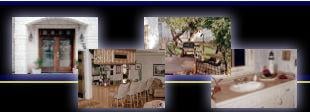Disability is a complex phenomenon — it represents the interaction between a person’s physical abilities, the activities they need to perform, and the architectural barriers within their surroundings. Each individual experiences this differently. Two people with the same impairment may describe their limitations in completely different ways. The blind navigate a world that is profoundly different from that of someone who is deaf — and both deserve spaces designed with equal accessibility in mind.
According to national reports, 19% of adults between ages 16 and 64 and 42% of those 65 and older live with a physical disability that affects their daily activities. These realities make it clear: accessibility isn’t just a senior issue — it’s a human one.
Building for All Ages and Abilities
This situation applies to everyone — adults, children, and individuals with special needs. The building industry must work together to ensure that every living environment meets essential human needs: safety, affordability, and structural integrity.
A truly accessible home supports privacy, belonging, control, safety, and security — the cornerstones of quality of life. These values should always guide the planning of any barrier-free design.
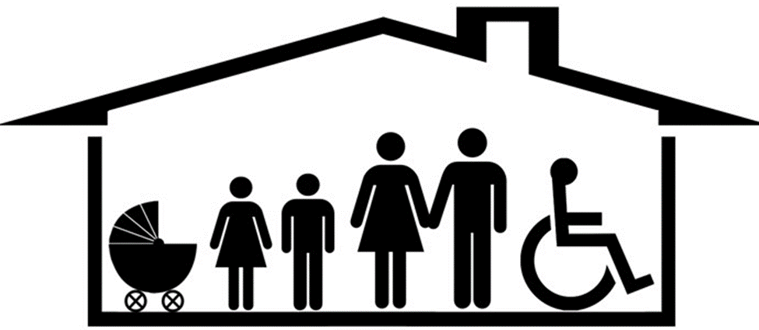
Common Barriers in Traditional Homes
Most traditional homes are full of hidden obstacles that restrict maneuverability for people with disabilities. These challenges become even more pronounced when mobility aids like walkers or wheelchairs are required.
Common architectural barriers include:
-
Steps at entryways with no alternative access
-
Narrow doorways and hallways with tight turns
-
Cramped bathrooms with poor fixture placement
-
Inaccessible outdoor spaces and patios
-
Kitchens that lack clear floor space or proper reach ranges
-
Hard-to-operate door hardware that requires grip strength and coordination
These design flaws can turn an ordinary house into a daily struggle for anyone with mobility limitations.
The Evolution of the Accessible Home
Accessibility has evolved far beyond grab bars and ramps. Modern accessible design is now built into the foundation of the home — seamlessly integrated rather than added as an afterthought.
This shift reflects the growing adoption of Universal Design, a concept that focuses on creating spaces, products, and environments usable by as many people as possible, regardless of age, ability, or circumstance.
Universal Design isn’t about making a home look institutional or medical. It’s about creating beauty, comfort, and functionality that everyone can enjoy — a design approach that feels natural, not clinical.
When done well, Universal Design improves safety and accessibility for every occupant and guest, often in ways that are practically invisible.
Accessible Home Design in Austin, Texas
For those in the Austin area seeking accessibility improvements, T-Square Company offers over 30 years of experience in barrier-free remodeling and accessible home design.
T-Square specializes in customized disability home modifications for residents of all ages, including:
- Expert and professional home assessments
-
Wider doors and hallways
-
Accessible bathrooms and roll-in showers
-
Barrier-free kitchens
-
Ramped entrances and zero-threshold transitions
-
Stair lifts, elevators, and vertical platform lifts
-
Fully accessible rooms designed to each client’s needs
Every design/build project begins with a clear understanding of the client’s abilities and goals, ensuring that the design solutions enhance both independence and comfort.

Meet David L. Traut, CAPS
David L. Traut, CAPS, owner and president of T-Square Company in Austin, Texas, is part of a select group of professionals nationwide who have earned the Certified Aging in Place Specialist (CAPS) designation.
This certification, offered through the National Association of Home Builders (NAHB) in collaboration with AARP, recognizes remodelers and builders trained to meet the unique needs of older adults and individuals with disabilities.
David is also certified in Universal Design in both the United States and Australia. Drawing on decades of expertise, he recently published Age in Place at Home: Adapting the Home Environment for All Generations, a comprehensive guide that explores the role of Universal Design in creating safe, accessible homes. David wrote this book as a means to help families through difficult times once their homes lacked optimal livability.
📘 Age in Place at Home takes readers room by room, explaining practical modifications that enhance safety, accessibility, and independence. The book is available now on Amazon.
Living Comfortably, Safely, and Independently
Never fear — almost any existing home can be modified to overcome accessibility challenges. With proper planning, professional guidance, and a bit of creativity, you can ensure that every family member enjoys comfort, safety, and freedom of movement.
Following the guidance in Age in Place at Home will not only improve your quality of life — it will also promote equality of access for everyone under your roof.
It just makes good sense.
Tags:
aging in place home modifications,
CAPS certified remodeling in Austin,
certified aging in place specialist,
aging in place design in Austin,
7 principles of universal design,
special needs contractor in Austin,
Austin disability contractors for special needs,
Austin aging in place specialist,
disability access contractor,
accessibility home modifications,
Austin home accessibility solutions,
CAPS-certified remodeling in Dripping Springs,
Dripping Springs special needs contractor,
universal design forever homes,
Universal Design for Disabilities,
Barrier-free designs,
Universal Design Building Professional in Austin,
home accessibility modifications,
safe bathroom design for seniors,
how to age in place
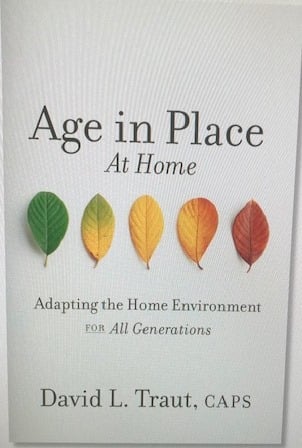
Before and after retirement is an excellent time to prepare the house for what might come next in life—before any significant health issues appear. Choosing to Age in Place earlier in life using Universal Design techniques means a family can longer enjoy the home without obstruction. Their relatives, visitors, and children have peace of mind assured the aging loved ones or the chronically ill are safer living at home.
Everyone planning to remain in their existing home to Age in Place is looking for safety, security, familiarity, ease of use, and comfort. Homeowners and their families should immediately plan for their future housing needs and work from an Aging in Place design checklist. The current housing inventory does not offer the features needed for safety and accessibility in the numbers required to accommodate the growing demand creating a need for home modifications and a niche market. Savvy homeowners and their family have weighed the costs of institutional living compared to their home’s expenses. They also realize the difference in adhering to stringent rules in an institutional facility instead of independently and freely residing in their present home.

The truth is, with professional help, you can adapt almost any home environment to enable you and everyone else in the family to live within it safely to the fullest extent. Aging in place design is not age-related because disability can instantly strike any family member of any age. The need for increased home accessibility is the common thread in any situation. Universal Design or inclusive design is a design and building pathway making homes more accessible to all regardless of their age, mobility, or ability when appropriately used. The Universal Design process offers a seamless path for Aging in Place providing help for those with a sudden disability. It additionally addresses the requirements of special needs families or multigenerational living situations. The elements of Universal Design provide common sense solutions for diverse living conditions.
Regardless of size or ability, people are becoming more familiar with Universal Design and Aging in Place when considering a home remodeling project. Some people use these words interchangeably, but while they are similar in nature, they do differ because of the time they are performed. Both are specific design techniques used in making a home more comfortable and accessible for individuals of different abilities. Universal Design deals more with customized new dwellings and a proactive remodeling approach for people desiring to Age in Place prior to any health issues taking over their life. Comparatively, Aging in Place home modifications strictly involve the remodeling of existing homes to accommodate physical needs brought on by sudden health issues in a reactive manner. The costs for both processes represent a beneficial investment in your home for future needs as opposed to merely spending involving aesthetically pleasing remodeling projects.
As an Aging in Place Specialist and one of Austin's premier Aging in Place contractors, I came to realize existing homes typically contain cramped, twisting hallways with narrow doorways, bathrooms without adequate maneuvering space for decreased usability, kitchens without accessible storage and workspaces, and stepped home entries. These are all common home design flaws. Every one of these common household problematic areas falls short of any Aging in Place design features. Hence, the home building industry has always lacked inclusion for all homeowners with their ever-changing needs.

As a Certified Aging in Place Specialist CAPS(#1636580), I am confident my book, "Age in Place at Home", introduces you to a new way of thinking about your home's future. It acts a guide for solving diverse home needs for all people affected by varying physical conditions and aging. I decided to write this book due to many customer requests for a summation of suggestions to improve their home's accessibility, comfort, usefulness, and sustainability and, ideas they could share with others. The book is full of Aging in Place design guidelines gleaned from witnessing years of shortcomings in traditional homes. I based the information provided on countless past home walkthroughs and home assessments. Within my book, you can discover room-by-room the benefits of using the principles of Universal Design and how to incorporate them periodically throughout your living environment at your own pace. I furthermore guide you through a home, making suggestions for what will increase your and your family's future accessibility. You will notice the chapters involving the bathroom and kitchen are very extensive. They represent the most important rooms to consider when planning to Age in Place. The most utilized rooms in our homes must accommodate all diverse residents and visitors.
Would you please not allow your home to hold you or any of your loved ones captive within its walls. Learn how to enable your home to conform to you and the needs of your family. Please think ahead positively and proactively while preparing for the future. IT JUST MAKES GOOD SENSE.

According to the 2000 census, nearly 50 million people in the United States have some type of disability. Of this group, 6.8 million have a condition that makes it difficult to bathe, dress and get around the inside of their own homes. T-Square Company has the training and knowledge to help with disabilities because we are a Certified Aging in Place Specialist (CAPS).
#accessiblehomes
Tags:
ADA compliant kitchen cabinets,
ADA accessible,
barrier free access,
aging in place remodeling,
ADA remodeling,
aging in place remodels,
ADA kitchen cabinets,
handicap accessible bathrooms,
aging in place construction,
CAPS professional in Austin,
accessible home remodeling,
CAPS remodeling techniques,
disability home remodeling in Austin,
aging in place specialist,
aging in place services,
aging in place design,,
certified aging in place specialist,
handicap remodeling contractors in Austin,
handicap home modifications for disabled,
disability access bathrooms Austin,
universal design ideas,
Austin accessible home remodeling,
certified aging in place consultant in Austin,
aging in place specialist in Austin,
senior aging in place services,
home remodeling for disabled,
home accessibility help in Austin,
home remodeling for disabled in Austin Texas,
wheelchair accessible home remodeling in Austin,
universal design remodeling contractor,
principles of universal design,
disability contractor in Austin,
special needs contractor in Austin,
handicap accessible remodeling,
barrier free remodeling,
handicap accessible home modifications,
disability remodeling,
handicap bathroom remodel,
disability access contractor,
barrier free showers in Austin,
ADA vanity in Austin,
accessible bathroom remodel,
what is ada compliant,
accessible homes,
universal design contractor,
accessible housing,
Austin home remodeling for disabled,
modifying your home for a disabled child,
wheelchair accessible homes,
the basics of aging in place,
barrier free kitchens,
barrier free design,
Austin home accessibility solutions,
Age in Place at Home
A universal design-build project is appealing to all users. When correctly applied, any home area will be accented universally with stylish function and appears virtually invisible. Bathrooms, kitchens, family rooms, and bedrooms will all benefit the homeowner once the principles of Universal Design are applied. Examples of increased usability provided by Universal Design include wider doorways and hallways, enhanced lighting, non-slip flooring, contrasting colors within rooms, more accessible electrical controls and devices, curb-less showers, lever door hardware, more pull-out shelves, and drawers over cabinet doors, varying cabinet top heights, and water faucets and controls operable by a single hand or closed fist. Be advised, Universal design ideas do not strictly deal with accessibility or Aging in Place design. They do not implement precise ADA standards, but offers flexibility to add accessories now and later to those planning or the end user.
David L. Traut, CAPS (1636580), the president and owner of T-Square Company, is accredited in Universal Design in the United States and Australia and has written many papers on the subject. David not only practices integrating Universal Design in his local design/build projects, but he acts as a consultant directing customers who live out of his service area. He has now published a book covering how Universal Design overcomes today's problematic living situations within traditional homes due to their association with status-quo building concepts. Additionally, Universal Design offers a common-sense gateway for increasing accessibility and adaptability in future homes. T-Square Company in Austin, Texas has been offering design/build accessibility projects to their clients incorporating the principles of Universal Design for over twenty-five years. They specialize in Universal Design Ideas.
Universal Design construction or inclusive construction is used when a homeowner is smartly preparing for future life changes and want to remain in their existing home. The most significant advantage of using this innovative concept is that it smoothly prepares a home for Aging in Place. By gradually applying elements of Universal Design during periodic home remodeling projects, those specific home areas affected are Age in Place ready without being noticed until needed. The concept provides various human performance characteristics for people using spaces within their homes, including well-integrated usability features. These adaptations have a broad market appeal to everyone for achieving ease of use, safety, and convenience, accommodating an inevitable reality. The effects of a disability, aging and disease are tempered because adaptability is built into the design. The reality is that all people exist along a continuum of human performance as per their traits and characteristics, regardless of their age. A universal approach to design considers that everyone has varying degrees of ability and disability rather than someone who is either fully functional or disabled.
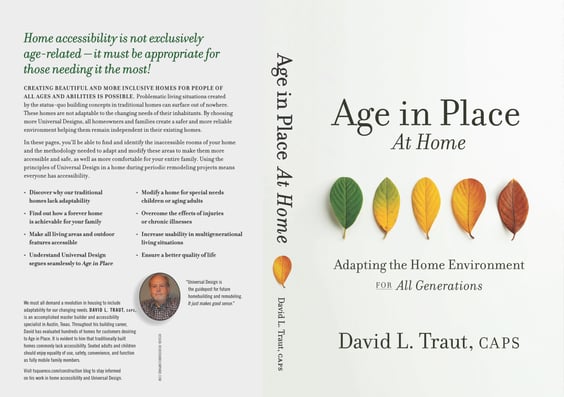
David L. Traut, CAPS, the owner-president of T-Square Company has published a book entitled "Age in Place at Home :Adapting the Home Environment for All Generations". The book is available through Amazon. This book covers identifying and overcoming common accessibility shortcomings found within a traditional home. Within it's pages, David takes you through a home's interior showing you how and where to apply Universal Design aspects in every room. Since Universal Design seamlessly segues into Aging in Place needs, it is a how-to book worth reading. Incorporating Universal Design principles into your home facilitate future Aging in Place goals, while comfortably addressing the diverse needs of all ages and mobility levels living within your home at any time. This book is a great reference for aging homeowners, parents of special needs children, homeowners moving in their elderly parents, and multi-generational living situations. Always remember, home accessibility is not exclusively age-related, but it must be appropriate for those needing it the most.
Universal Design construction and Aging in Place home modifications are available through T-Square Company in SW Austin, Texas. Each universal design/build project is customized to the homeowner's needs. Call 512-444-0097 today to prepare for the accessible second chapter of your life while remaining safe and secure in your existing home. T-Square Company will design and build an adapted living environment customized around your abilities. Whether your project concerns home modifications, an accessible addition or wing, or new construction, they can help you increase your accessibility. T-Square Company has over three decades of building and remodeling experience practicing as a disability contractor for people with special needs. They want to help their clients be as self-sufficient and independent as possible by offering handicap accessible floor plans. Let them show you how to increase safety and accessibility within your living environment.
After so long a time of blogging, soap box deliveries, and conversations with customers and other builders concerning the importance of Universal Design in the future of our home building industry, others have listened and agreed. David was humbled to find this article published in the Austin American Statesman. He takes pride in the fact that people are beginning to see the importance of this very forward-thinking design concept because it just makes good sense. May this article help to propel the needed universal building movement forward.

The trend toward 'universal design' in homes
Tuesday, Jan 15, 2019 @ 3:57pm
By David Wilfong
Simple adjustments like a sideways opening oven can make life a lot easier for a person in a wheelchair. | Jofre Essley / Flickr
For many years disabled people faced challenges at every corner of public life. Stairs, rough ground, or even just reaching objects on a shelf created obstacles at inopportune times. Then the Americans with Disabilities Act (ADA) came into play. Wheelchair ramps and handicapped restrooms became commonplace in common spaces, and the result has been an improved quality of life for millions.
Then there’s the subject of home design. Homes have been modified for many years to meet the needs of the disabled, but now there is a new concept of “universal design,” which means homes being built for all needs from the beginning, even if there is not currently a disabled person living there.
“Along with aging in place, universal design is becoming more of a household term,” says T-Square Company (14141 Highway 290 West, Suite 800 in Austin) in is online blog. “Essentially, it’s about building or modifying places and spaces—both public and private—to accommodate people of all ages and abilities. More than just an architectural concept, universal design is a win-win for sandwich generation boomers caring for aging parents and their children at home, for grandparents raising grandchildren and great-grandchildren, and for all who are facing the challenges of caring for a loved one with Alzheimer’s or other chronic diseases. Whether your family needs the support now or down the road, universal design features are a good long-term investment for the home itself.”
The trend toward 'universal design' in homes
Tuesday, Jan 15, 2019 @ 3:57pm
By David Wilfong
Tags:
universal design/build,
universal design/build ideas,
universal design building for a lifetime,
universal design remodeling techniques,
universal design remodeling contractor,
universal design building contractor,
universal design principles,
7 principles of universal design,
universal principles of design,
disability access contractor,
accessible home remodeling for disabilities,
accessible bathroom design specifications,
professional remodeling contractor,
accessible bathroom remodel,
specialty construction in Austin,
accessible homes,
home access in Austin,
universal design/build contractor,
universal design vs. aging in place,
universal design contractor,
home accessibility,
accessible design,
accessible housing,
handicap accessible housing,
handicap accessible house plans,
accessible homes in austin,
universal design techniques,
Austin home remodeling for disabled,
accessible home modifications,
handicap accessible floor plans,
accessible home builder in Austin,
wheelchair accessible homes,
special needs contractor,
universal home design in Austin,
universal design home builder,
universal design home additions,
universal design building consultant,
universal design forever homes,
Universal design construction,
Universal design construction in Austin,
Universal Design Professional in Austin,
Universal Design Building Professional in Austin
Disability is a complex phenomenon representing an interaction between one's physical impairments, the activities one needs to perform, and the architectural barriers within the space in which this situation occurs. Each individual demonstrates the complexity with similar impairments describing his or her limitations differently. The blind don't experience their world the same as a person with deafness. Some of our societal statistics that weigh into Aging in Place situations include reports stating that 19% of the population between the ages of 16 and 64 and 42% of those of us 65 and over have a physical disability affecting the activities of their daily lives.
The situation holds true for adults, and for children with special needs. The building world must work in unison to be sure the entire living environment meets basic needs in addition to affordability and structural integrity for the consumer and homeowner. This includes the home and the components within the home being accessible to all inhabitants needing it most once architectural barriers become a recognized problem for any particular family member regardless of age or ability. Privacy, a sense of belonging, a sense of control, and the sense of safety and security make up the quality of life for any home and should be considered for any barrier-free design.
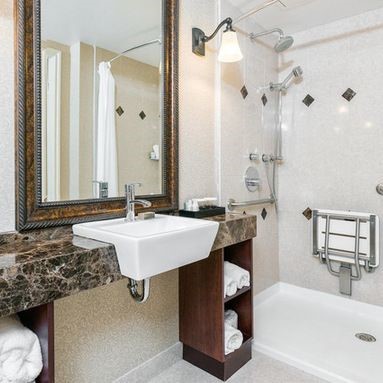
Traditional homes are commonly full of barriers restricting maneuverability for anyone with a disability. This situation is accentuated once any mobility device is required. Houses typically exhibit home entrances involving steps, narrow doorways, tight hallways with abrupt turns, cramped bathrooms inhibiting comfortable fixture use, inaccessible outside amenities, congested and unfriendly kitchens, and door locking hardware requiring hand strength and coordination.
The concept of the accessible home has evolved beyond the basic grab bars and ramps to one in which accessibility is built into the basic design. Everyone ages differently and has different needs and wants. These factors have brought about the need for Universal Design. This is the design of products, services, and environments usable by as many people as possible regardless of age, ability, or situation without needing adaptation or specialized alterations. It provides the most significant safety and access for home guests or occupants and is undetectable when done well. The principles of Universal Design enable living in a home with more comfort and adaptability for people of all ages and abilities.

Fortunately for people needing increased accessibility beyond what their existing home offers, there is home accessibility help available in Austin, Texas, offered by T-Square Company. T-Square Company specializes in handicap accessible homes and barrier-free remodels having over 30 years of accessibility experience. They provide customized disability home modifications for any age resident with special needs. T-Square Company offers a complete assortment of disability services to help cushion and adapt to any disability including barrier-free home design/build projects. Wider entries and hallways, accessible bathrooms and showers, accessible kitchens, ramped entrances, vertical platform lifts, stair lifts, elevators, and accessible rooms of any type are just a few of the services offered. Every design is based on the specific needs and abilities of the client.
David L. Traut, CAPS the owner and president of T-Square Company in Austin, Texas is one of the select group of professionals nationwide to earn the Certified Aging in Place Specialist (CAPS) designation, identifying him as a home remodeler and builder with the skills and knowledge necessary to remodel or modify a home to meet the unique needs of the older population, disabled owners, or their visitors. Additionally, he is certified in Universal Design in the United States and Australia. David has recently published a book called "Age in Place at Home: Adapting the Home Environment For All Generations". The book explains the importance of Universal Design in building taking you through every room of the home in order to increase home accessibility. It is available on Amazon.
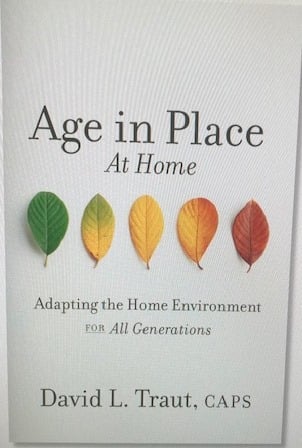
Never fear. You can adapt almost any existing home environment to overcome difficulties and enable you and everyone else in the family to comfortably live at home and move around safely with correct planning and know-how.
Your quality of life will improve if you follow the book's advice. The positive result is every family member has equal accessibility throughout your home's interior. IT JUST MAKES GOOD SENSE.

Tags:
handicap home modifications,
disability home remodeling in Austin,
elder construction,
certified aging in place specialist,
handicap accessibility,
disability and special needs contractor Austin,
bathrooms with disability access in Austin, Texas,
barrier free remodeling,
disability access contractor,
barrier free design,
disability and special needs in dripping springs,
increase home accessibility,
barrier-free remodels
Our homes have always been exempt from any of the federal accessibility regulations put in place in 1990. Unfortunately, no restricted codes or regulations concerning residential bathrooms or disability access baths exist. An evolving concept called Universal Design satisfies most people's personal needs. Universal Design techniques in the building make a home more accessible to all regardless of size, mobility or adaptive abilities. Children and aging adults benefit in the home from its existence. The evolution of new products used for disability home modifications makes those homes more accessible and has finally come about in the remodeling industry. Specialized handicap remodeling contractors for home remodeling incorporating the principles of Universal Design are catching on nationwide and have been a sign of the times for several years. Our present-day obsolete homes, now inhabited by the baby boomer generation, will slowly and increasingly raise their obsolete ugly heads and expose their true lack of accessibility to those inhabiting them.

When mobility becomes an issue for any homeowner, regardless of age, the question arises concerning physically moving to a different home that is more accessible. Universal Design prepares your home for one of those highly likely events involving someone needing room modifications for even a short time while recovering from surgery or the chronically ill. Solving Aging in Place issues will soon become the number one challenge concerning our country's obsolete housing inventory. The situation will only expand with an increasingly aging population due to medical advances. When these homes were previously purchased, they represented a complete castle in the world of their owners in which to prepare for a day, and they also acted as a retreat from life's challenging interactions. They housed our families, our memories, and our stuff. They represented a place where we could be ourselves.
There are many benefits to using Universal Design techniques, including potential use by aging family members or special-needs children, added resale value, and the fact that you'll be creating a space that can be used by anyone who visits your home, regardless of their range of abilities. Simple universal design updates for Aging in Place home modifications and handicap bathroom accessibility can include adding grab bars or handrails throughout the home, adding a seat within the roll in shower, lowering upper cabinets and countertops, adding non-slip flooring, widening hallways, or installing stair lifts, and widening doors. You might also consider lowering light switches and thermostats and installing easier-to-use door levers. Try to provide a clear barrier-free path or accessible route to the most visited areas of your home. These new advances in accessible home remodeling make living environments safer and will not compromise the home's aesthetics.

Many people find themselves needing accessible homes for themselves or family members. There are approximately 30 million Americans using wheelchairs, and the number of people who need accessible homes will continue to increase as disabled and aging people find more ways to remain in their homes. Furthermore, children with special needs make up a significant part of the population. One crucial way to increase independent living is by making a home accessible to an individual's personal needs. Home modifications can increase safety, accessibility, and independence for people who want to live independently.

Universal Design runs parallel with wheelchair access. Many of the published guidelines for wheelchair-accessible remodeling, particularly requirements for corridor and door widths, safety bars, and proper access to different rooms, can go a long way in extending the amount of time an elderly or physically impaired individual can live independently. The absolute truth about the design process is that if it allows access by a seated person, it gives everyone access. More comfort is built into a room while avoiding a cramped and cluttered living environment because there is adequate room to move about freely.
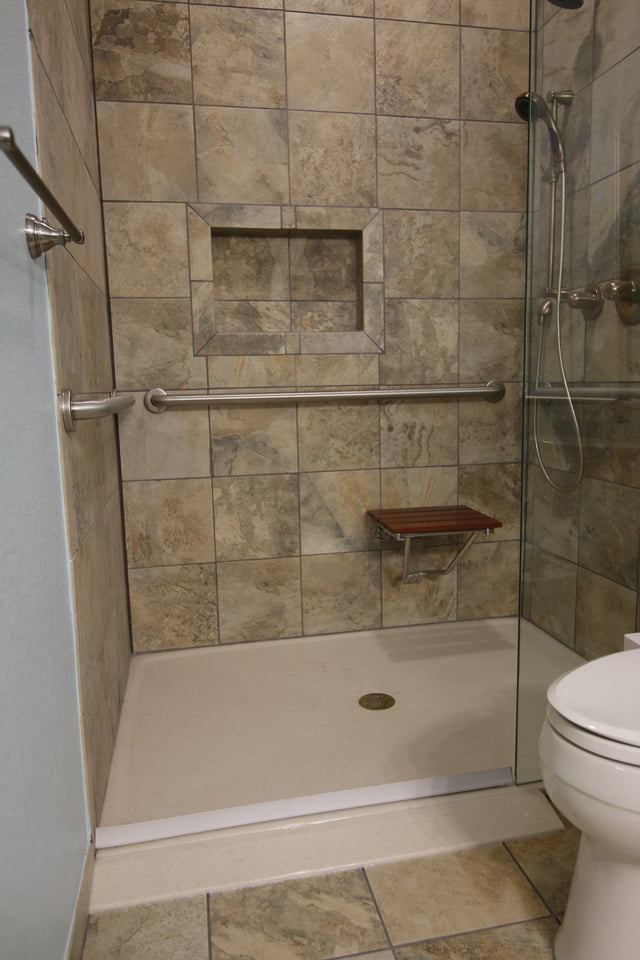

An Aging in Place (CAPS) specialist must design an Aging in Place project. Always consider the end user's preferences and capabilities. For instance, roll-in showers without curbs are advised for everyone on a universal basis for an accessible bath. A 5'x5' clear shower floor turning space is an optimum size when a caretaker is involved. Using a 32-36" wide barrier-free entrance in a shower partition with an out-swinging door is advised for everyone to increase safety. Remember, wider is better in all respects. Upon exiting the shower, a clear floor space of 30"x48" for an approach to the shower should be present. This area can overlap with the designated five feet turning radius area within the room. The shower should contain a hand-held shower wand on a sliding bar or mast mounted 48" above the floor and is available for varying heights of use. The hand shower is complimented by a fixed height shower head located at approximately seven feet above the shower floor. These diverse shower heads are both regulated using a diverting controller valve.You can opt for the fixed shower head if you desire a full body wash or the hand-held is used for rinsing and shower cleaning. This configuration allows adaptability within the design. Hence, the user has a choice. Always use a shower valve that is thermostatically controlled and pressure-balanced to prevent scalds.
Installing fixtures with a scald guard or lowering the temperature at the water heater is a must to prevent burns. Fold-down seats attached to the shower wall are useful if caretakers are involved. Recessed shampoo niches help eliminate clutter on the shower floor. Secure grab bars installed on wood grounds buried within the wall around the entire shower perimeter at 34-36" above the finished shower floor increases the safety factor and helps to prevent falls. A recessed can light fixture should be installed above the shower area for proper lighting. To prevent slipping on a guaranteed wet floor, all bathroom floor surfaces must be the nonskid type. The ultimate goal in accessible design is to make the bathroom space safe for everyone who uses the bathroom. Universal Design better accommodates wheelchair users and makes the bathroom more comfortable for all users. This modification can be done without sacrificing style.

The National Association of Home Builders, in partnership with the AARP and Home Innovation Research Labs, created the CAPS program, which includes training and education on the technical, business management, and customer service skills essential to compete in the fastest-growing segment of the residential remodeling industry--home modifications for Aging in Place using Universal Design. David L. Traut, CAPS, the owner of T-Square Company in SW Austin, Texas, is one of the select group of professionals nationwide to earn the Certified Aging-In-Place Specialist (CAPS) designation, identifying him as a home remodeler and builder with the skills and knowledge necessary to remodel or modify a home to meet the unique needs of the older population, disabled owners, or their visitors.
Tags:
ADA accessible,
accessible routes,
barrier free access,
aging in place remodeling,
aging in place home modifications,
aging in place,
wheelchair accessible remodeling,
wheelchair accessible baths and kitchens,
handicap home modifications,
ADA remodeling,
ADA compliance,
disability bathroom remodels,
handicap accessible bathrooms,
aging in place construction,
aging in place designs,
custom tub to shower conversions,
wheelchair accessible baths,
accessibility home remodeling in Austin,
CAPS professional in Austin,
CAPS certification holder in Austin,
accessible home remodeling,
CAPS remodeling techniques,
Universal Design,,
Austin bathroom remodel,
disability home remodeling in Austin,
home modifications for independent living,
disability bathroom remodeling in Austin,
bathroom modifications for elderly,
aging in place specialist,
aging in place services,
aging in place design,,
elder construction,
certified aging in place specialist,
handicap remodeling contractors in Austin,
disability home modifications in Austin,
Austin elder construction,
remodel bathroom for handicap Austin Texas,
handicap home modifications for disabled,
handicap accessibility,
handicap remodeling contractors,
bathroom modifications for disabled,
bathroom accessibility remodels in Austin,
accessibility remodelers in Austin,
ADA remodeling Austin, Texas,
ADA bathroom Austin, Texas,
wheelchair accessible showers in Austin,,
roll in showers,
accessibility designs Austin Texas,
handicap bathrooms,
ADA compliant wheelchair accessible showers,
roll in shower design for wheelchair access,
disability access contractor,
accessible home remodeling for disabilities,
accessibility home modifications,
Universal Bathroom Design,
Universal Design for Disabilities
Universal Design Construction or inclusive construction is used when a homeowner is smartly planning for life changes within their home. The most significant advantage of using this innovative concept is that it smoothly prepares a home for Aging in Place. By gradually applying elements of Universal Design into periodic home remodeling projects, those specific home areas are Age in Place ready without being noticed until needed. The concept provides various human performance characteristics for people using spaces within their homes, including well-integrated usability features. These adaptations have a broad market appeal to everyone for achieving ease of use, safety, and convenience, accommodating an inevitable reality. The effects of aging and disease are tempered because adaptability is built into the design. The reality is that all people exist along a continuum of human performance as per their traits and characteristics, regardless of their age. A universal approach to design considers that everyone has varying degrees of ability and disability rather than someone who is either fully functional or disabled.
A universal design-build project is appealing to all users. When correctly applied, any home area will be accented universally with stylish function and appears virtually invisible. Bathrooms, kitchens, family rooms, and bedrooms will all benefit the homeowner once the principles of Universal Design are applied. Examples of increased usability provided by Universal Design include wider doorways and hallways, enhanced lighting, non-slip flooring, contrasting colors within rooms, more accessible electrical controls and devices, curb-less showers, lever door hardware, more pull-out shelves, and drawers over cabinet doors, varying cabinet top heights, and water faucets and controls operable by a single hand or closed fist. Be advised, Universal design ideas do not strictly deal with accessibility or Aging in Place design. They do not implement precise ADA standards, but it offers flexibility to add accessories now and later to those planning or the end user.
Universal Design construction and Aging in Place home modifications are available through T-Square Company in SW Austin, Texas. Each universal design/build project is customized to the homeowner's needs. Call 512-444-0097 today to prepare for the accessible second chapter of your life while remaining safe and secure in your existing home. T-Square Company will design and build an adapted living environment customized to your abilities. Whether your project concerns home modifications, an accessible addition or wing, or new construction, we can help you increase your accessibility. We have over three decades of building and remodeling experience practicing as a disability contractor for people with special needs. We want to help our clients be as self-sufficient and independent as possible by offering handicap accessible floor plans. Let us show you how to increase safety and accessibility within your living environment.
David L. Traut, CAPS (1636580), the president and owner of T-Square Company, is accredited in Universal Design in the United States and Australia. He has written many papers on the subject and is in the process of finishing a book called Age in Place at Home: Adapting the Home For All Generations. The book covers how Universal Design avoids today's problematic living situations by traditional home's association with status-quo building concepts. Universal Design offers a common-sense gateway for increasing accessibility and adaptability in future homes. It will be available soon from Amazon.
After so long a time of blogging, soap box deliveries, and conversations with my customers concerning the importance of Universal Design in the future of our home building industry, others have listened and agreed. I was humbled to find this article published in the Austin American Statesman. I take pride in the fact that people are beginning to see the importance of this very forward-thinking design concept. May this article help to propel the needed universal building movement forward.

The trend toward 'universal design' in homes
Tuesday, Jan 15, 2019 @ 3:57pm
By David Wilfong
Simple adjustments like a sideways opening oven can make life a lot easier for a person in a wheelchair. | Jofre Essley / Flickr
For many years disabled people faced challenges at every corner of public life. Stairs, rough ground, or even just reaching objects on a shelf created obstacles at inopportune times. Then the Americans with Disabilities Act (ADA) came into play. Wheelchair ramps and handicapped restrooms became commonplace in common spaces, and the result has been an improved quality of life for millions.
Then there’s the subject of home design. Homes have been modified for many years to meet the needs of the disabled, but now there is a new concept of “universal design,” which means homes being built for all needs from the beginning, even if there is not currently a disabled person living there.
“Along with aging in place, universal design is becoming more of a household term,” says T-Square Company (14141 Highway 290 West, Suite 800 in Austin) in is online blog. “Essentially, it’s about building or modifying places and spaces—both public and private—to accommodate people of all ages and abilities. More than just an architectural concept, universal design is a win-win for sandwich generation boomers caring for aging parents and their children at home, for grandparents raising grandchildren and great-grandchildren, and for all who are facing the challenges of caring for a loved one with Alzheimer’s or other chronic diseases. Whether your family needs the support now or down the road, universal design features are a good long-term investment for the home itself.”
The trend toward 'universal design' in homes
Tuesday, Jan 15, 2019 @ 3:57pm
By David Wilfong
Tags:
universal design/build,
universal design/build ideas,
universal design building for a lifetime,
universal design remodeling techniques,
universal design remodeling contractor,
universal design building contractor,
universal design principles,
7 principles of universal design,
universal principles of design,
disability access contractor,
accessible home remodeling for disabilities,
accessible bathroom design specifications,
professional remodeling contractor,
accessible bathroom remodel,
specialty construction in Austin,
accessible homes,
home access in Austin,
universal design/build contractor,
universal design vs. aging in place,
universal design contractor,
home accessibility,
accessible design,
accessible housing,
handicap accessible housing,
handicap accessible house plans,
accessible homes in austin,
universal design techniques,
Austin home remodeling for disabled,
accessible home modifications,
handicap accessible floor plans,
accessible home builder in Austin,
wheelchair accessible homes,
special needs contractor,
universal home design in Austin,
universal design home builder,
universal design home additions,
universal design building consultant,
universal design forever homes,
Universal design construction,
Universal design construction in Austin
Universal design is the design of products and environments to be usable by all people, to the greatest extent possible, without the need for adaptation or specialized design. Some universal design/build ideas just make good sense. Once you bring them into your home, you'll wonder how you ever lived without them. Universal Design isn’t just for the elderly or the permanently disabled. As Americans age, they’re beginning to realize that their homes need to accommodate future life changes. Consumers are more cognizant today of the benefits of a universally designed home, but they may not realize it can be beautiful as well as functional. Everyone can use universal design! It doesn't matter if you are young or old. You could be short or tall, healthy or ill. You might have a disability or you may be a star athlete. Because of universal design ideas, people who are very different can all enjoy the same home. And that home will be there for all its inhabitants even when their needs change.
Try to envision building a house as a young adult so that you can live in comfort while you age no matter what your basic physical needs require. This adaptable and inclusive design home contains wide doorways and hallways that can accommodate both a stroller and a wheelchair or walker. There is a wide-open feeling throughout the house's main living areas. The bathroom, kitchen, and living area do not restrict moving about by anyone. There is blocking behind the finished walls to accommodate secure grab bar installations when needed. Carefully chosen towel racks in the kitchen double as grab bars as you become unsteady from lack of balance. All the entryways from the front door to the shower entrance are smooth to prevent tripping from high thresholds. All doors and faucets are controlled by a lever or other graspable hardware. This universally designed home is a barrier-free design without looking modified and is accessible to everyone no matter their age, size, or capability of movement. This home is accessible to everyone from your father to your son.
Universal design ideas do not strictly deal with accessibility or aging in place design and do not implement precise ADA standards but it does offer flexibility to add accessories now and later to those planning ahead or to the end-user. It also provides for a wide range of human performance characteristics for the way people use spaces within their homes including well-integrated usability features. These adaptations have a broad market appeal to everyone for achieving ease of use, safety, and convenience accommodating a certain reality. The reality is that all people exist along a continuum of human performance as per their personal traits and characteristics regardless of their age. A universal approach to design takes into account that everyone has varying degrees of ability and disability rather than someone is either fully-functional or disabled. A universal design/build project is appealing to all users. When correctly applied, any area of the home is accented universally with stylish function and is virtually invisible. The functionality of the home never calls attention to any of its inhabitants. It also segues seamlessly into Aging in Place.
If you have decided to stay in your existing home as you age, Aging in place home modifications are available through T-Square Company in Austin, Texas using the principles of Universal Design. We are one of the premier universal design/build contractors in Austin. We hold certifications in the U.S. and Australia. Each universal design/build project is customized to fit any and all homeowner's personal needs. T-Square Company will design and build you an adapted living environment completely customized around your abilities. We have over three decades of building and remodeling experience practicing as a disability contractor for people with special needs. We want to help our clients be as self-sufficient and independent as possible by offering handicap-accessible floor plans. Let us show you how to increase safety and accessibility within your personal living environment. Call 512-444-0097 today to begin to prepare for the accessible second chapter of your life while remaining safe and secure in your existing home. Whether your project concerns home modifications, an accessible addition or wing, or new construction we can help you increase your accessibility using our Universal Design/build experience.
David L. Traut, President, and Owner, CAPS 1636580 (Certified Aging in Place Specialist)

It appears that after so long a time spent blogging, soapbox deliveries, and conversations with my customers concerning the importance of Universal Design in the future of our home building industry others have listened and are in agreement. I was humbled to find this article published in the Austin American Statesman and take pride in the fact that people are beginning to see the importance of this very forward-thinking design concept. May this article help to propel the needed universal building movement forward. You can read the article for yourself.
The trend toward 'universal design' in homes
Tuesday, Jan 15, 2019 @ 3:57pm
By David Wilfong
Simple adjustments like a sideways opening oven can make life a lot easier for a person in a wheelchair. | Jofre Essley / Flickr
For many years disabled people faced challenges at every corner of public life. Stairs, rough ground, or even just reaching objects on a shelf created obstacles at inopportune times. Then the Americans with Disabilities Act (ADA) came into play. Wheelchair ramps and handicapped restrooms became commonplace in common spaces, and the result has been an improved quality of life for millions.
Then there’s the subject of home design. Homes have been modified for many years to meet the needs of the disabled, but now there is a new concept of “universal design,” which means homes being built for all needs from the beginning, even if there is not currently a disabled person living there.
“Along with aging in place, universal design is becoming more of a household term,” says T-Square Company (14141 Highway 290 West, Suite 800 in Austin) in an online blog. “Essentially, it’s about building or modifying places and spaces—both public and private—to accommodate people of all ages and abilities. More than just an architectural concept, universal design is a win-win for sandwich generation boomers caring for aging parents and their children at home, for grandparents raising grandchildren and great-grandchildren, and for all who are facing the challenges of caring for a loved one with Alzheimer’s or other chronic diseases. Whether your family needs the support now or down the road, universal design features are a good long-term investment for the home itself.”
Tags:
disability access contractor,
accessible home remodeling for disabilities,
accessible bathroom design specifications,
professional remodeling contractor,
accessible bathroom remodel,
specialty construction in Austin,
accessible homes,
home access in Austin,
universal design/build contractor,
universal design vs. aging in place,
universal design contractor,
home accessibility,
accessible design,
accessible housing,
handicap accessible housing,
handicap accessible house plans,
accessible homes in austin,
universal design techniques,
Austin home remodeling for disabled,
accessible home modifications,
handicap accessible floor plans,
accessible home builder in Austin,
wheelchair accessible homes,
special needs contractor,
universal home design in Austin,
universal design building consultant

Everyone planning to remain in their home to Age in Place is looking for safety, security, ease of use, and comfort. Homeowners and families must plan for future housing needs. The current housing inventory does not offer the features needed for safety and accessibility in the numbers required to accommodate the growing demand. They have weighed the costs of institutional living compared to their home’s expenses. They also realize the difference in adhering to stringent rules in a facility instead of independently and freely residing in their present home.
Before and after retirement is an excellent time to prepare the house for what comes next in life—before any significant health issues appear. Choosing to Age in Place earlier in life using Universal Design techniques means a family can longer enjoy the home without obstruction. Their relatives, visitors, and children have peace of mind assured the aging loved ones or the chronically ill are safer living at home.
The truth is, with professional help, you can adapt almost any home environment to enable you and everyone else in the family to live within it to the fullest extent safely. The process is not age-related. Disability can strike any family member at any age. The need for greater home accessibilty is the common thread. Universal Design or inclusive design is a design and building pathway that makes homes more accessible to all regardless of their age, mobility, or ability when appropriately used. The design process offers a seamless path for Aging in Place. It addresses the requirements of special needs families or multigenerational situations. Solutions for diverse living conditions are now becoming a possibility.
Regardless of size or ability, people are becoming more familiar with Universal Design and Aging in Place if considering a home remodeling project. Some people use these words interchangeably, but while they are similar, they do differ. Both are specific design techniques used in making a home more comfortable and accessible for individuals of different abilities. Universal Design deals more with customized new dwellings and a proactive remodeling approach for people wanting to Age in Place before any health issues arise. Aging in Place strictly involves remodeling existing homes to accommodate physical needs brought on by sudden health issues in a reactive manner. The costs for both processes represent a beneficial investment in your home for future needs as opposed to merely spending involving aesthetically pleasing remodeling projects.
I came to realize over my building career that including cramped twisting hallways with narrow doorways, bathrooms lacking maneuvering space and usability, kitchens without accessible storage and workspaces, and stepped home entries were repeating home design flaws. The home building industry has always lacked inclusion for all homeowners with their ever-changing needs.

As a Certified Aging in Place (CAPS) professional (#1636580), I am confident this book, which will hopefully be available toward the end of 2022, will introduce you to a new way of thinking about your home's future. It offers a guide for solving diverse home needs for all people affected by varying physical conditions and aging. I decided to write this book due to many customer requests for a summation of suggestions to improve their home's accessibility, comfort, usefulness, and sustainability and, ideas they could share with others. I based the information provided on countless past walkthroughs and home assessments. Inside, you can discover room by room the benefits of using the principles of Universal Design and how to incorporate them periodically throughout your living environment at your own pace. I guide you through a home, making suggestions for what will increase your and your family's future accessibility. You will notice the chapters involving the bathroom and kitchen are pretty extensive. They represent the most important rooms to consider when planning to Age in Place. The most utilized rooms in our homes must accommodate all diverse residents and visitors.
Would you please not allow your home to hold you or your loved ones captive within its walls and enable your home to conform to you and the needs of your family. Please think ahead positively and proactively while preparing for the future. IT JUST MAKES GOOD SENSE.

#accessiblehomes
Tags:
ADA compliant kitchen cabinets,
ADA accessible,
barrier free access,
aging in place remodeling,
ADA remodeling,
aging in place remodels,
ADA kitchen cabinets,
handicap accessible bathrooms,
aging in place construction,
CAPS professional in Austin,
accessible home remodeling,
CAPS remodeling techniques,
disability home remodeling in Austin,
aging in place specialist,
aging in place services,
aging in place design,,
certified aging in place specialist,
handicap remodeling contractors in Austin,
handicap home modifications for disabled,
disability access bathrooms Austin,
universal design ideas,
Austin accessible home remodeling,
certified aging in place consultant in Austin,
aging in place specialist in Austin,
senior aging in place services,
home remodeling for disabled,
home accessibility help in Austin,
home remodeling for disabled in Austin Texas,
wheelchair accessible home remodeling in Austin,
universal design remodeling contractor,
principles of universal design,
disability contractor in Austin,
special needs contractor in Austin,
handicap accessible remodeling,
barrier free remodeling,
handicap accessible home modifications,
disability remodeling,
handicap bathroom remodel,
disability access contractor,
barrier free showers in Austin,
ADA vanity in Austin,
accessible bathroom remodel,
what is ada compliant,
accessible homes,
universal design contractor,
accessible housing,
Austin home remodeling for disabled,
modifying your home for a disabled child,
wheelchair accessible homes,
the basics of aging in place,
barrier free kitchens,
barrier free design,
Austin home accessibility solutions,
Age in Place at Home
As a universal design/build construction company located in Austin, Texas, T-Square Company realizes that building for your future changing needs is a very valuable consideration concerning all your periodic remodeling projects. We always design for the future for our clients, regardless of their age or abilities. This thought process is especially true when designing a bathroom upgrade. Being a nationally CAPS certified remodeler, we are very aware your personal needs can change in the blink of an eye. The daily tasks of getting into the bathroom, bathing, showering, using the toilet, or brushing your teeth can become almost impossible without assistance if you don't address your bathroom's inaccessibility in a proactive manner. Any revisions must be completed before you absolutely need the help. Design shortcomings become ever so noticeable if you have an accident and are recovering at home or a debilitating disease sets in. Most all problems caused by architectural barriers will be eliminated with a handicap accessible bathroom remodel.
We are certain that avoiding emergency remodeling while incorporating Universal Design techniques into your home whenever possible is a great way of enhancing your health, independence, and safety. This practice also provides a better overall quality of life. The sooner the main inaccessible areas in your home are addressed, the longer you and your family have to enjoy them. For those desiring to Age in Place, as in safely living in your own home for as long as possible, gradually incorporating the principles of Universal Design into all remodeling projects provides a seamless gateway for successful aging. So, what are the main concerns when designing a bathroom for the future?
Getting Into The Bathroom
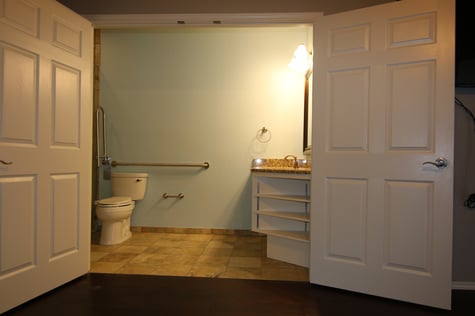
When possible, you should always install a 36-inch wide door into your bathroom allowing all mobility devices to enter without obstruction. Sometimes it's easier when walls cannot be altered or removed to make a large double door entry into the bathroom. Replacing the original twenty-four to twenty-eight-inch wide door offers maximum accessibility for anyone. This universal design element provides clear approaches toward all bathroom fixtures from an adjoining room. Additionally, an unobstructed 60-inch wheelchair turning radius is shared by the bathroom and adjacent room.
An Accessible Shower
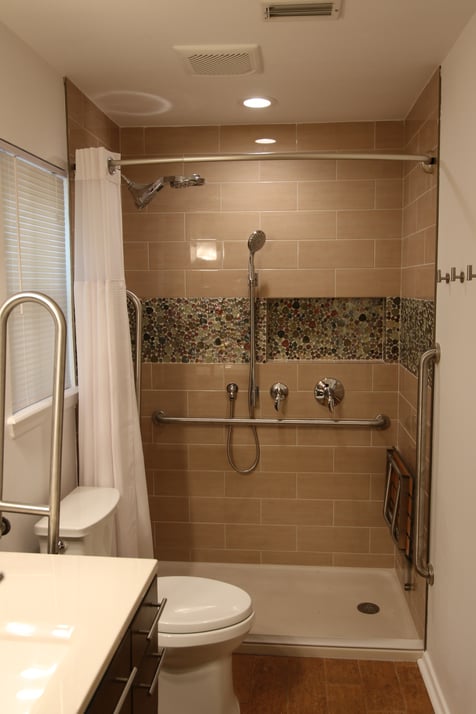
A safe, low-profile (1 1/2" tall) accessible shower with roll-in capability from an add-on ramp suits the needs of most diverse homeowners. Even if you don't require the grab bars during a particular phase of your life, installing adequate blocking before the tile is installed provides a universal path for your future needs once the bars are required. Take note, the grab bars must be able to withstand a shear force of 300 pounds. Their purpose is to provide support and stability when you need it most. Clutter within the shower and especially on the shower floor is a safety hazard. Recessed shampoo niches keep shampoo bottles and other items off the floor. Additionally, folding shower seats are far safer than free-standing models that are rarely ever in the right place. They save space when folded while not in use and never interrupt the use of a shower chair. It is a common misconception that shower controls must be mounted on one wall underneath the fixed shower head. Shower valves can be installed anywhere they are most convenient for the user, especially if a caretaker is involved. A recessed shower can light above the shower decreases shadows and further increases safety.
Using The Toilet
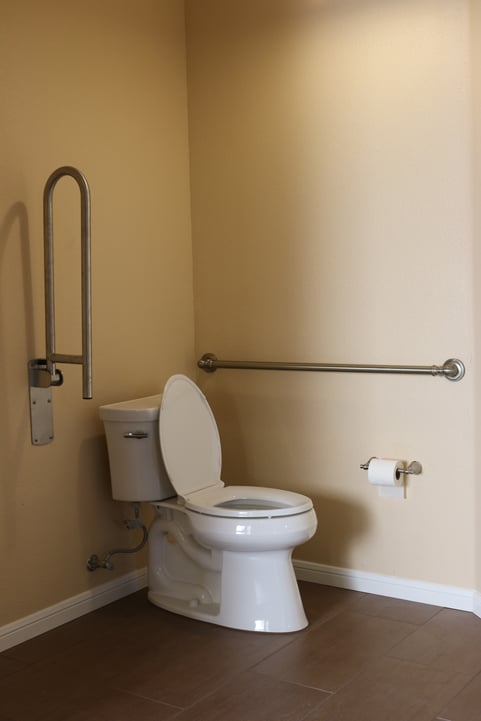
When a toilet exists in a confining room or space, there is no easy way of approaching it if you have mobility problems and especially if you are using any kind of mobility device. After all, safety is the predominant concern when using the toilet. Remove all restricting walls and narrow doors so everyone can freely approach and use the toilet. Once again, grab bars increase safety when they are required and must be adequately prepared for installation. Another problem with toilets involves those that are too short requiring deep knee bends for using them. A higher comfort height toilet offers significant help with this problem. Be sure the flush handle is toward the open side of the bathroom.
Brushing Your Teeth
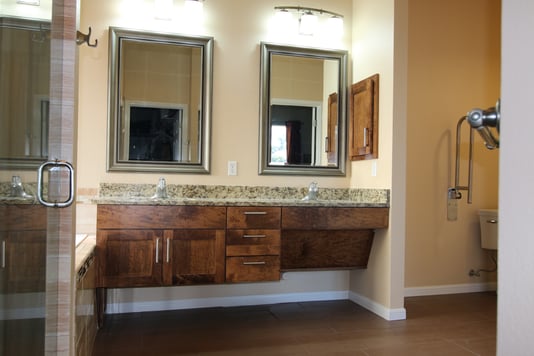
Offering adaptability in a vanity is a universal design aspect. Everyone has equal access while standing or using a wheelchair--if only for a short time during recoveries. More adaptability is offered using multiple height countertops. Lever faucets are easier for everyone to operate, even for those users with arthritis. Motion-sensor faucets create washing areas that are completely hand-free.
When you are ready to take the next steps toward your accessible future, contact T-Square Company in Austin, Texas. We can show you how to address your personal needs using our more than thirty years of knowledge and design/build accessibility experience. We guarantee to keep you safer in your existing home longer and out of dangerous and uncaring institutions using our proven design methods. We offer all handicap accessible home renovations or additions--especially accessible bathrooms.
David L. Traut, CAPS #1636580
Tags:
aging in place remodeling,
custom walk in showers,
certified aging in place specialist,
ADA bathroom Austin, Texas,
disability access bathrooms Austin,
Austin Handicap Remodeling,
universal design ideas,
universal design building for a lifetime,
home accessibility help in Austin,
universal design remodeling contractor,
7 principles of universal design,
applying principles of universal design in Austin,
handicap accessible remodeling,
barrier free remodeling,
disability remodeling,
handicap bathroom remodel,
ADA compliant wheelchair accessible showers,
disability access contractor,
veterans home accessibility help in Austin, Texas,
barrier free showers in Austin,
accessible bathroom design specifications,
ADA vanity in Austin,
accessible toilets,
what is an ADA compliant bathroom,
universal design/build contractor,
universal design vs. aging in place,
home accessibility,
accessible design,
why universal design,
what is aging in place,
accessibility home modifications,
handicap bathroom vanity,
handicap accessible floor plans,
maneuvering in and around the accessible home,
future home building using universal design,
universal design home additions
The present out of control housing market situation prompted a search for answers solving the question of how to create houses capable of meeting the needs of tomorrow while accommodating future life changes. There is no one size fits all home design because everyone’s life experience is unique to them creating a diverse society with diverse physical needs. Using Universal Design, the wide ranging abilities of the homeowner is a major consideration for all successful inclusive and adaptable designs in homes. The absence of the Universal Design principles entering into all existing home architectural endeavors is perpetuating the lack of accessible housing urgently needed for the lifespan of every homeowner. To increase the acceptance of this design concept by everyone, especially the consumer, Universal Design must become a topic of conversation through knowledge and basic understanding. This depends on the members of the broadest populations’ acknowledgement of the need for the use of this practical idea.
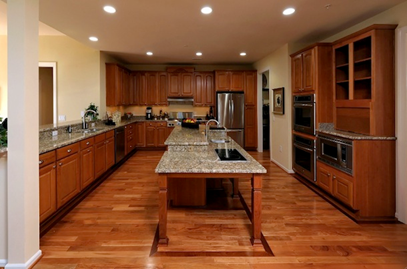
Universal Design plays a significant role in the future accessibility of all home designs. Homeowners must base design decisions on the seven (or eight) principles of Universal Design. Deciding which universal features to include in future forever homes is the most alluring question. Each principle is very useful in itself. The more principles involved in the design process, the greater the adaptable outcome of the home. After all, the smart forward thinking homes of the future depict long term sustainable assets for life allowing Aging in Place to seamlessly follow as people age and evolve. It is true Universal Design emerged out of the accessible and adaptive architectural movement; however, it constantly attempts to combine aesthetics with basic core values for every user. While moving us toward an accessible future, appearing invisible, Universal Design recognizes peoples’ bodies, needs, and lifestyles constantly change along a continuum due to the aging process. Universal Design acknowledges too that everyone ages differently as individuals. One person’s disability type is not experienced like another’s. It is better to live in a more open and comfortable Universal Design home with the flexibility of evolving with the homeowner rather than one which at some uncertain time becomes an impasse during the homeowner’s lifetime.

Embracing Universal Design with its many values and advantages for all people during timely remodeling projects or while building a new home is needed if society is ever going to escape the inaccessible cookie cutter homes of today. Additionally, this design technique offers a win-win solution helping solve problems encountered by multi-generational households. The multi-generational homes of today create the greatest personal accessibility challenges for all the generations involved. The application of Universal Design principles is desperately needed to sustain the choice of living environments for these diversified families. Universal Design homes have the unique ability of simultaneously accommodating strollers, walkers, or wheelchairs within the home without regard to a person’s size, age, or abilities. Furthermore, these homes contain lasting value if the owner ever decides to sell appealing to all society groups. To the uninformed, the folklore associated with Universal Design has stigmatized the process in home building today. This has much to do with why such a unique building concept is not greeted with open arms by the consumer. Beliefs like, it costs more, it takes up too much space, it will make my home have less resale value, it will look institutional, or only a few people could benefit from it represent a select few.
While Universal Design sounds appealing in conversations, it is rare to actually witness it in the built environment. The Universal Design movement recognizes its slow acceptance hinges on historic ties related to being a disability solution. This way of thinking causes implications for consumers and the world of home design presenting a huge misconception. Universal Design never distanced itself from the need for increased accessibility during the disability movement of the 80’s and therefore is mired in ADA jargon producing an indelible unfocused brand. As an inclusive design, Universal Design pertains to overcoming the barriers and stereotypes associated with its terminology in order to stand out as the next and final trend in future housing. Universal Design has no limits for the varying groups of people it helps. Every family member is included when using this design methodology whether they are abled or disabled, short or tall, young or old. With education, people understand Universal Design is the most revolutionary element in housing design today. Once realized how the principles of Universal Design affect everyone in the quest for maximum inclusion, consumers might start paying better attention to this logical building concept. Future home dwellers are fortunate in having this transitional and adaptable design concept in their vocabulary. Possibly they distinguish the designs flexibility as the gateway for tomorrow homes built and designed for everyone at every age. Only then, when people grasp the importance of Universal Design, does it become an everyday building term and a much needed household solution. No longer are personal desires for Aging in Place creating total disruption during life’s waning years. It is successfully accomplished seamlessly following the accessibility offered by Universal Design.

Tags:
ADA compliant kitchen cabinets,
accessible routes,
barrier free access,
wheelchair accessible baths and kitchens,
CAPS certification,
custom walk in showers,
ADA kitchen cabinets,
wheelchair accessible baths,
CAPS professional in Austin,
Universal Design,,
aging in place specialist,
aging in place design,,
handicap accessibility,
roll in showers,
accessibility designs Austin Texas,
roll in showers in Austin,
universal design/build,
universal design ideas,
Austin Accessibility Design,
certified aging in place consultant in Austin,
aging in place specialist in Austin,
universal design building for a lifetime,
what is universal design,
home accessibility help in Austin,
universal design kitchen ideas,
universal design remodeling techniques,
universal design remodeling contractor,
why is universal design important,
universal design principles,
7 principles of universal design,
universal principles of design,
Universal Principles of design revised and updated,
principles of universal design,
applying principles of universal design in Austin,
special needs contractor in Austin,
disability and special needs contractor Austin,
bathrooms with disability access in Austin, Texas,
ADA compliant wheelchair accessible showers,
disability access contractor,
barrier free showers in Austin,
ADA compliant roll in showers,
wheelchair accessible shower stalls,
roll in shower,
accessible bathroom design specifications,
wheelchair accessible toilets,
barrier free toilets,
handicap accessible toilets,
what is ada compliant,
home access,
accessible homes,
home access in Austin,
universal design/build contractor,
universal design vs. aging in place,
universal design contractor,
accessible design,
why universal design,
wheelchair accessible housing,
handicap accessible housing,
accessible homes in austin,
accessibility home modifications,
wheelchair accessible bathroom,
handicap bathroom design,
modifying your home for a disabled child,
accessible home builder in Austin,
wheelchair accessible homes,
universal home design in Austin,
the basics of aging in place,
how the life cycle affects aging in place,
applying universal design,
maneuvering in and around the accessible home,
Universal Design Garages,
Universal Bathroom Design,
Universal Design Bedroom,
universal kitchen design,
wheelchair accessible kitchens,
universal design kitchen,
barrier free kitchens,
disability access kitchens,
the universal design laundry,
barrier free laundry,
future home building using universal design,
universal design home builder,
universal design home additions,
barrier free design,
barrier free home design


























